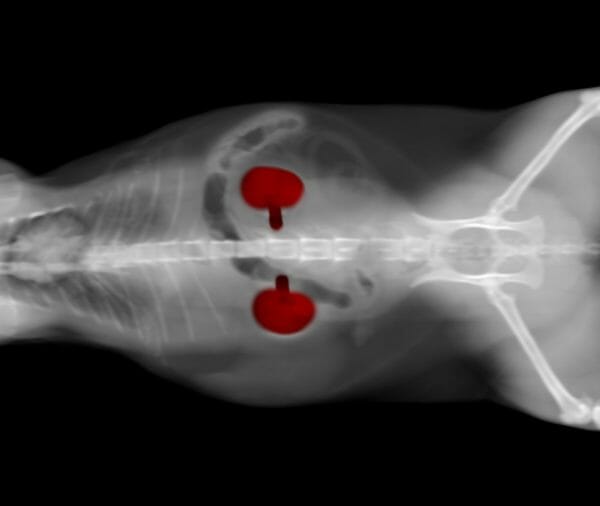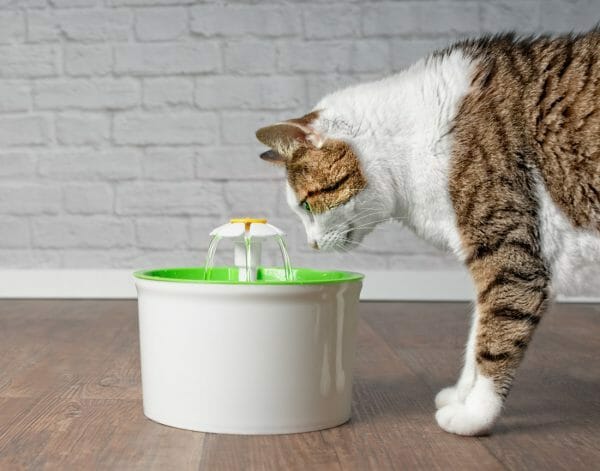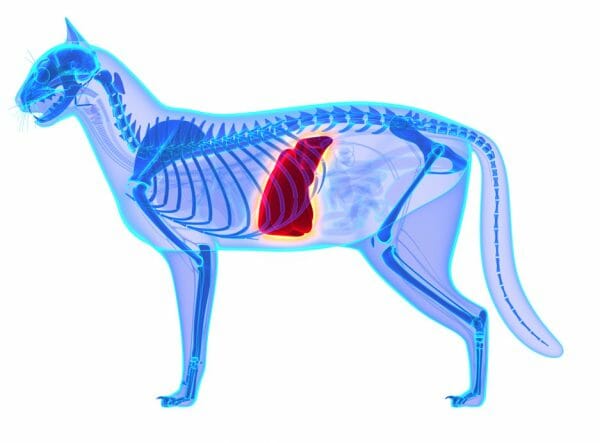What Is Amyloidosis?
Amyloidosis in cats occurs when cellular proteins become abnormally folded and are deposited into various tissues and organs. Because the abnormal proteins cannot be dissolved via normal digestion and breakdown processes, these deposits (known as amyloids) begin to displace the normal cells in the affected organs or tissues. As a result, the amyloids can damage the organs and tissues, and they begin to fail. When critical organs are infected, amyloidosis can lead to organ failure and death.

The two organs most affected by the condition are the kidney (renal amyloidosis) and liver (hepatic amyloidosis). Senile systemic amyloidosis is often seen in older felines. Fortunately, amyloidosis in cats is relatively rare. However, certain breeds of cats are more prone to amyloidosis, which may have a genetic component. Cat breeds most prone to renal amyloidosis are:
Cat breeds that are more prone to hepatic amyloidosis include:
- Abyssinians
- Siamese
- Oriental Shorthairs
- Devon Rex
What Causes Amyloidosis in Cats?
Most amyloids form in response to some kind of severe inflammation, which might be caused by chronic infections, cancer, or a chronic inflammatory disease—such as feline inflammatory bowel disease (IBD). These types of amyloids are called AA amyloids. AA amyloids are usually deposited in organs such as the kidneys, liver, or spleen.
Another kind of amyloids—AL amyloids—typically form in felines with certain types of cancer (usually plasma cell tumors or myelomas). These types of amyloids tend to be deposited in nerve tissue or joints. AL amyloids can lead to neurological problems.
As mentioned earlier, Abyssinians, Siamese, and other cat breeds can also experience hereditary (familial) amyloidosis. However, when renal amyloidosis is diagnosed, it almost always occurs in an Abyssinian cat. For this reason, Dr. Richard Goldstein—an Associate Professor of Small Animal Medicine at Cornell University College of Veterinary Medicine—suggests that Abyssinian owners have bloodwork done annually when the cat is young and twice-yearly once the cat is older.

Signs of Renal Amyloidosis in Cats
If too many amyloids are deposited in the kidneys, kidney function will begin to deteriorate. Because the kidneys are responsible for removing metabolic waste (such as urea, mineral salts, and other potentially harmful substances) from blood, felines with compromised kidney functioning will have increasing difficulty in removing these toxins from their bodies. Renal amyloidosis may also lead to blood clotting problems and an accumulation of fluid in the limbs and abdomen.
Signs of renal amyloidosis in cats are similar to the signs of chronic kidney disease. Symptoms include:
- Increased drinking
- Excessive urination
- Reduced appetite and weight loss
- Vomiting
- Diarrhea
- Dehydration
- Swollen legs

Signs of Hepatic Amyloidosis in Cats
Hepatic amyloidosis happens when amyloids are deposited into the liver. This condition sometimes occurs in conjunction with renal amyloidosis or other liver issues, such as high liver enzymes, severe enlargement of the liver, coagulation disorders, a rupture of the liver, or liver failure.
Signs of hepatic amyloidosis in cats include:
- Weakness and lethargy
- Abdominal pain
- Decreased appetite
- Weight loss
- Vomiting
- Yellowish tinge to the skin or the whites of the eyes
- Pale gums
- Distended abdomen
- Poor coat quality

Diagnosing Amyloidosis in Cats
It can be challenging for a veterinarian to diagnose amyloidosis in cats because the disease mimics many other feline diseases. In addition, the condition is fairly uncommon. In many cases, felines with symptoms that resemble amyloidosis tend to have a more common condition—kidney or liver disease—rather than this disorder.
However, if the symptoms appear in a cat breed known to be susceptible to the condition, the vet may come to a diagnosis more quickly. For example, if an Abyssinian cat between the ages of 1 and 5 shows signs of rapid and progressive kidney failure, amyloidosis would be suspected.
Diagnostic tools used by a vet include a complete blood count and chemistry panel, a urinalysis, X-rays, and ultrasounds. However, a definitive diagnosis will require a biopsy. For example, a cat with renal amyloidosis will have a kidney that appears to be normal to the naked eye or in an X-ray or ultrasound. (In other cases of feline renal disease, the kidneys often look shrunken or misshapen.) However, under a microscope and using special stains, the areas affected by the amyloid deposits are revealed.
Unfortunately, because most felines with amyloidosis are already displaying the clinical signs of organ failure, a definitive diagnosis of the disease is often only made after the cat’s death.

Treating Amyloidosis in Cats
Sadly, there is no proven treatment for amyloidosis in cats. The abnormal folding of the proteins cannot be reversed, undone, or prevented. As a result, the primary treatment for felines diagnosed with amyloidosis focuses on treating the symptoms and monitoring the feline’s organ function. In some cases, the inflammation causing the amyloids to form might be stopped or slowed down, which would decelerate the disease progression. This is the best-case scenario.
Felines with renal amyloidosis will most likely be hospitalized for kidney failure—receiving IV fluids to help treat the condition. Once the condition is stabilized, the cat will be discharged and treated at home with medication and a special diet focused on kidney health. However, because there is no known way to reverse the process of the amyloids forming, the disease will continue to progress. Some felines will also develop high blood pressure (hypertension), which can be treated. However, most cats with renal amyloidosis have a life expectancy of less than a year.
Cats that develop hepatic amyloidosis are usually diagnosed between the ages of 1 and 5. If the amyloids are deposited slowly, affected cats may live for a few years before liver function becomes inadequate. If the amyloids are deposited into the liver more quickly, the survival rate is typically less than a year.
Although there is a genetic factor linked to the development of amyloidosis, there are no screening tools available right now. Currently, the only way to prevent passing the condition on to other cats is to prevent cats who develop amyloidosis from breeding. Because the condition is familial (occurs within families), the parents, brothers, sisters, offspring, and grandparents of cats diagnosed with amyloidosis should not be bred.




